Software Processes
The term software specifies to the set of computer programs, procedures and associated documents (Flowcharts, manuals, etc.) that describe the program and how they are to be used.
A software process is the set of activities and associated outcome that produce a software product. Software engineers mostly carry out these activities. These are four key process activities, which are common to all software processes. These activities are:
- Software specifications: The functionality of the software and constraints on its operation must be defined.
- Software development: The software to meet the requirement must be produced.
- Software validation: The software must be validated to ensure that it does what the customer wants.
- Software evolution: The software must evolve to meet changing client needs.
The Software Process Model
A software process model is a specified definition of a software process, which is presented from a particular perspective. Models, by their nature, are a simplification, so a software process model is an abstraction of the actual process, which is being described. Process models may contain activities, which are part of the software process, software product, and the roles of people involved in software engineering. Some examples of the types of software process models that may be produced are:
- A workflow model: This shows the series of activities in the process along with their inputs, outputs and dependencies. The activities in this model perform human actions.
- 2. A dataflow or activity model: This represents the process as a set of activities, each of which carries out some data transformations. It shows how the input to the process, such as a specification is converted to an output such as a design. The activities here may be at a lower level than activities in a workflow model. They may perform transformations carried out by people or by computers.
- 3. A role/action model: This means the roles of the people involved in the software process and the activities for which they are responsible.
There are several various general models or paradigms of software development:
- The waterfall approach: This takes the above activities and produces them as separate process phases such as requirements specification, software design, implementation, testing, and so on. After each stage is defined, it is "signed off" and development goes onto the following stage.
- Evolutionary development: This method interleaves the activities of specification, development, and validation. An initial system is rapidly developed from a very abstract specification.
- Formal transformation: This method is based on producing a formal mathematical system specification and transforming this specification, using mathematical methods to a program. These transformations are 'correctness preserving.' This means that you can be sure that the developed programs meet its specification.
- System assembly from reusable components: This method assumes the parts of the system already exist. The system development process target on integrating these parts rather than developing them from scratch.
Software Crisis
- Size: Software is becoming more expensive and more complex with the growing complexity and expectation out of software. For example, the code in the consumer product is doubling every couple of years.
- Quality: Many software products have poor quality, i.e., the software products defects after putting into use due to ineffective testing technique. For example, Software testing typically finds 25 errors per 1000 lines of code.
- Cost: Software development is costly i.e. in terms of time taken to develop and the money involved. For example, Development of the FAA's Advanced Automation System cost over $700 per lines of code.
- Delayed Delivery: Serious schedule overruns are common. Very often the software takes longer than the estimated time to develop, which in turn leads to cost shooting up. For example, one in four large-scale development projects is never completed.
Program vs. Software
Software is more than programs. Any program is a subset of software, and it becomes software only if documentation & operating procedures manuals are prepared.
There are three components of the software as shown in fig:

1. Program: Program is a combination of source code & object code.
2. Documentation: Documentation consists of different types of manuals. Examples of documentation manuals are: Data Flow Diagram, Flow Charts, ER diagrams, etc.

3. Operating Procedures: Operating Procedures consist of instructions to set up and use the software system and instructions on how react to the system failure. Example of operating system procedures manuals is: installation guide, Beginner's guide, reference guide, system administration guide, etc.

|



 For Videos Join Our Youtube Channel: Join Now
For Videos Join Our Youtube Channel: Join Now










